
Installing a Micro-Drip Irrigation System
Micro Drippers, used in a Micro Drip System, can be discreetly disguised amongst plants to release water slowly in droplets. Micro Drippers ensures zero water wastage and deliver water exactly and directly to the plant’s roots. They offer a flexible method of watering, as drippers can be custom placed along the length of pipe in an infinite number of combinations to create a unique irrigation system.
This Guide Contains:
A Quick Guide to Micro Drippers
Tips for Installing a Micro Drip System
Setting Up a Micro Drip Irrigation System
How to Install a Micro Drip System
Maintaining a Micro Drip System
A Quick Guide to Micro Drippers
Micro Drip irrigation systems can be easily installed in both established gardens and gardens where you are just starting out. Before you install your system, ensure the soil quality of your pots and planters retains water well. If the soil is too loose or nutrient-poor, water will quickly drain away and you will need to run your Drip System more frequently. Good plant-enriching soil has a PH of around 6-6.5 which can be checked using a PH Tester Kit. Mix an ericaceous compost into your soil if the PH is too high or aerate/turn over your soil if your PH is too low. Alternatively, mixing a good garden compost into your soil will increase the level of nutrients and plant-benefiting organisms.
Key Features of Micro Drippers
Drippers can be either In-Line or End of Line.
End of Line drippers have one barbed inlet and can be placed at the end of a line of drippers in a large planter, or singularly in pots. In-Line drippers have barbed inlets on either side for connection to Micro Pipe to allow a continuous flow of water. Multiple in-Line drippers can be set up in a long chain to water a trough/large planter.
Depending on what you want to water we offer a range of different litre per hour (L/h) outputs. Use the below recommendations:
- • 2 L/h Output - Suitable for watering seedlings or plants requiring less water.
- • 4 L/h Output - For larger plants/shrubs that need more water to thrive including, vegetable plots and borders.
- • 8+ L/h Output – Perfect for watering newly establishing plants, large shrubs and trees.

Our HydroSure Range of Micro Drippers
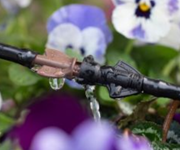
Adjustable Drippers: Allow you to regulate and control your system as each turn/click indicates an increase or decrease in flow rate. The dripper can also be turned off when not needed. Suitable for gardens with plants that require varying amounts of water.
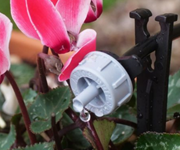
Pressure Compensating Drippers: Ensure a consistent flow rate regardless of pressure or elevation in the system. Every dripper emits exactly the same amount of water whether it is at the beginning or end of the system. Suitable for more complex garden layouts.
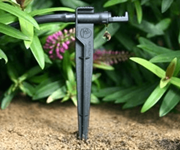
Spike Mounted Drippers: Can be pushed into the ground at the most suitable height for your plant. Spike mounted drippers are attached to supply pipe using 4mm Micro Pipe. The spike ensures ultimate stability and anchorage in the ground to prevents the dripper moving around. This ensures minimal water wastage and accuracy when delivering water directly to the plant’s roots.
Tips for Installing a Micro Drip System
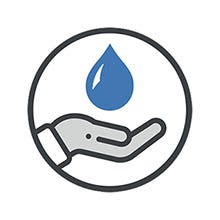
Water Saving Irrigation
A Micro Drip system uses significantly less water than manual watering and sprinkler systems. This is because drippers can be positioned to deliver water with pinpoint accuracy directly to the roots of the plant where it is needed most. Micro Drip systems offer environmentally friendly irrigation and reduce weed growth by removing water wastage on the soil surface where weeds can thrive.
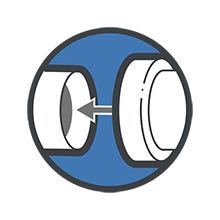
Easy to Connect System
Micro Drippers can be easily adapted if you change the placing of your potted plants or garden design. Simply remove the dripper from the pipe, use a Goof Plug to plug the existing hole and a Hole Punch when placing drippers in new locations. You can also easily extend your system by adding more supply pipe and connecting more drippers.
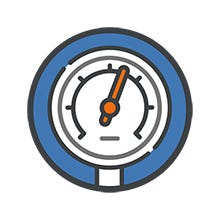
Working Pressure
Micro Drip systems work best at water pressures around 1.5 bar. The water pressure from your tap usually exceeds the required pressure for a Micro Drip system to function optimally. It is, therefore, recommended to use a Pressure Reducer at the start of your system to regulate the pressure to the correct level.
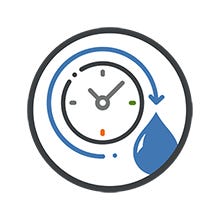
Automate Your Watering
Automating your watering means you no longer have to spend time watering your garden or even turn on the tap. Instead, install any Water/Tap Timer that suits your budget and set it to the times and frequency you would like to water. Using an automated system not only means you save time for other activities but, also means plants can continue to thrive even when you go on holiday.
Top Tip: Set your timer to water early in the morning or late in the evening to avoid any water wastage from evaporation during the mid-day sun.
Setting up a Micro Drip Irrigation System
1. Starting From the Tap
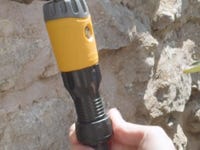
Begin by attaching a Back Flow Preventor to avoid contaminating your water source.
Then, attach a Tap Timer followed by an Irrigation Filter to prolong the life of your drippers and prevent dirt and small particles from entering and damaging the drippers.
A 1 to 1.5 bar Pressure Reducer should then be installed to the filter to regulate the pressure to the correct level.
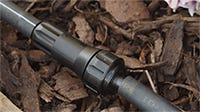
2. Supplying your Micro Drip System
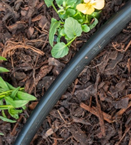
Micro Drip Systems need to be supplied using 14mm LDPE Irrigation/Supply Pipe. LDPE pipe has a more rigid wall and maintains its shape when the dripper is inserted. This ensures the system does not leak where the dripper is installed.
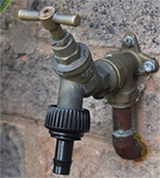
Attach LDPE Pipe to your tap using a Barbed Tap Connector threaded directly onto your Filter/Pressure Reducer/Tap depending on your set up.
Drippers can be inserted directly into LDPE pipe after creating a hole using a Hole Punch, which accurately creates a 4mm hole that matches the size of the barb. Most Hydrosure drippers feature an ergonomic shelf for easy insertion into the pipe using your thumb and forefinger.
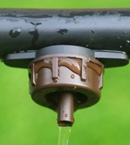
3. Using Micro Pipe
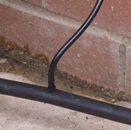
To install in-line drippers, use 4mm pipe to take drippers to plant's roots. Micro pipe's internal diameter means friction inside the pipe increases, so only install in 4m run lengths.
To install simply use a Hole Punch to insert a hole where you want to feed your Micro Pipe from. Next, use a 4mm Barbed Joiner and push it into the hole just created.
Attach the Micro Pipe to the other end of the joiner by pushing it on past the barb.
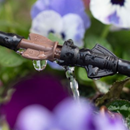
Then, take your pipe up to the plant you wish to water and use Pipe Cutters to cut the pipe to length. At the end of the pipe, insert the barbed end of the dripper.
Top Tip: Similar to LDPE pipe, you may find it easier to dip the pipe in hot water so it is easier to push onto the barb. When the pipe cools, it contracts around the barb ensuring a watertight seal.
4. Using Connectors
Fix LDPE pipe and Micro Pipe to a wall or fence at any height using Wall Clips or Saddle Clamps to keep your pipe line tidy.
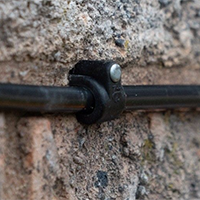
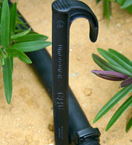
Pipe Stakes anchor the pipe in place to ensure micro drippers remain in place and point directly to where they need to water.
Make sure you use a Fold Over End Stop/End Plug at any open end of your system to maintain the pressure.
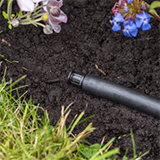
Direct pipe around corners using Barbed/Nut Lock Elbows or in different directions using Barbed/Nut Lock Tees to feed the LDPE pipe to the plants you want.

How to Install a Micro Irrigation System
Planning your Micro Drip System
Begin by sketching a rough plan of your garden layout indicating your water source and labelling planting areas/individual plants you would like to water. Next, mark on your plan if you will need In-Line or End of Line Drippers and if you need these to be Essential, Adjustable, Pressure Compensating or Spike Mounted Drippers.
Top Tip: To give yourself more flexibility when planning your system, we recommend buying additional drippers.
You will also need to measure both the size of the area you would like to water and the distance between each watering area. Add this to your plan as this will indicate the length you need to cut your pipe. Take into account components you will need to direct your pipe line around your garden and any Stakes and Wall clips you may need to keep pipe tucked out of the way and avoid any trip hazards.
Calculating your Flow Rate
A Micro Drip system requires minimum pressure to efficiently run. To calculate how many drippers you can run from your water supply you must first calculate your Water Flow Rate.

Use the above calculation to work out your flow rate in Litres per hour then divide this figure by the Litres per hour your Micro Dripper emits. This will tell you how many Drippers you can run from your tap. For more information, visit our Guide to Measuring Water Pressure.
How Long to Run a Drip System For
It's healthier to run your system less often and for longer; this allows for deeper soil penetration and healthier plants. Not only does this decrease the chance of evaporation and uses less water but also means water is available to the roots for longer.
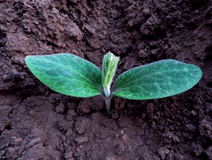
Avoid running your drip system for frequent, shorter periods as this causes roots to stay near the surface and dry out more quickly making plants more subject to stress and disease.
To find out a run time most suited to your garden’s watering needs, start by running your system two or three times a week for 40 minutes. After each watering cycle, check the water has penetrated the soil to a depth of at least 8 inches. The soil should be damp but not saturated. If the soil is still dry, increase the run time rather than the frequency.
Top Tip: Cover the soil in mulch or bark to further avoid water loss through evaporation. Make sure you don’t bury the drippers as dirt can get into the mechanisms of drippers reducing their performance.
Zoning Your System
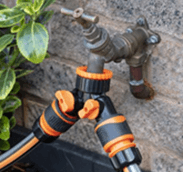
If you have a large garden and are looking to split your system into watering zones, a Dual Outlet Timer or Water Distributor means each zone has at least the minimum pressure to run efficiently. You can also use an Outlet Water Distributor to both run your system and use your hose pipe from your tap without having to disconnect one to use the other.
Top Tip: We recommend printing out graph paper using it to plan your system.
Maintaining a Micro Drip System
Steps for Winterising your Micro Drip System
A Micro Drip System does not need to be taken apart during the winter months. All you need to do is follow the two steps below:
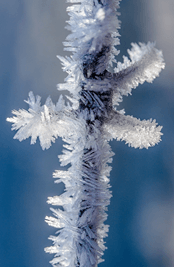
1: Water/Tap Timers, Filters and Pressure Reducers are more delicate items that will need to be protected in colder weather. Before the first frosts, clean your filter and pressure reducer in a bucket of water and empty any water out.
Empty your Timer of any sitting water, remove the batteries and store it upright in an undercover garage or shed. Keep in mind you may need to replace more delicate items in your system every 1-2 years.
2: To reduce the impact of thawing and freezing inside your pipe line remove any End Stops/Plugs/Caps from your system to allow any sitting water to drain out.
Unclogging Your Irrigation System
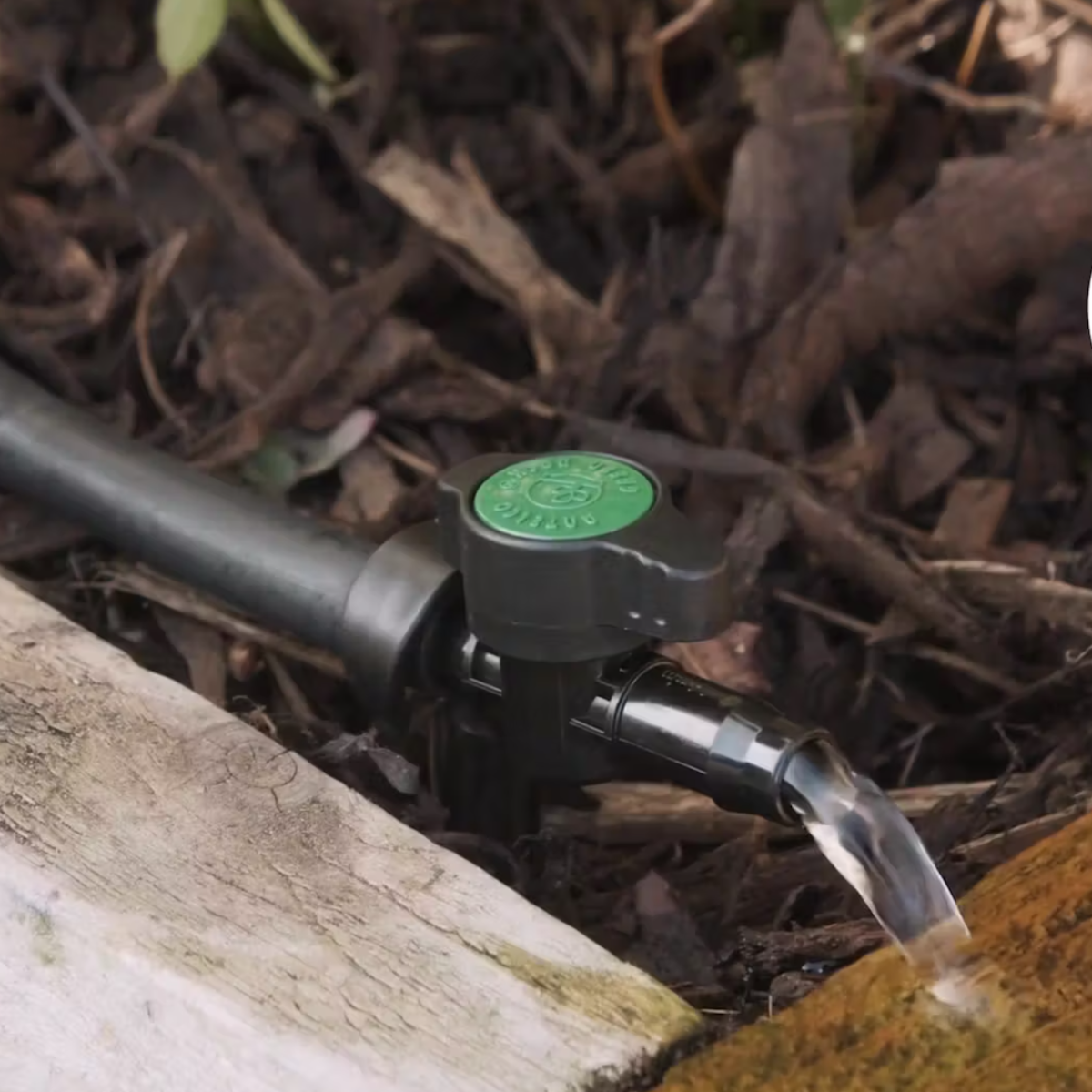
Regularly flushing the system by removing the End Stops/Plugs and turning on the tap flush out debris circulating around your Drip-System. Repeating this process around twice a month keeps your system working at its peak and prolongs the life of your drippers.
Top Tip: Remember to replace the End Plugs after this process.
Caring for Your System in Spring/Summer
In order to keep your Drip-Irrigation system running at its peak, you will need to carry out some occasional basic maintenance.

Firstly, ensure the filter remains clean and the internal mesh screen is intact. To do this, unscrew the filter cover to reveal the internal mechanism and clean out any debris using a bucket of clean water.
Next, walk around your system to check each emitter is working correctly and does not need cleaning or replacing. To ensure your dripper is working efficiently, visually look to see that water is dripping from the outlet. A dripper that is not emitting any water may mean the dripper requires cleaning or you need to flush the system.
Repairing Your Drip System
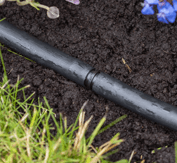
When digging in the garden, you may pierce or split your LDPE pipe causing it to develop a leak. To repair your system, remove the hole/leak using Pipe Cutters saving as much of the LDPE Pipe as you can.
Then, use a Barbed Joiner/Nut Lock Joiner to reconnect and repair your Pipe. You may wish to turn the system on at the tap to test if this connection is watertight.
Cleaning An Irrigation System
Flushing An Irrigation System
Maintaining A Micro Filter
Repairing Split Irrigation Pipe
Our Recommendations - Micro Drip Systems
HydroSure Drip Kits
If you are looking for a Complete Solution to watering your garden, browse our Ready to use Drip Kits. Hydrosure Drip Kits are available in various sizes with a choice of kits including or excluding a Tap Timer. They contain all the necessary components you need to create a drip system fully customisable to your garden layout. Hydrosure Drip Kits can be used to water all areas of your garden including, pots, planters, greenhouse plants, beds and borders.
Top Tip: For larger gardens or more complex layouts, you can further adapt your Drip Kit by adding more Pipe Line and more Drippers to extend your watering system.
Indoor Watering Drip kit
If you find you are often forgetting to water your indoor plants, you can use an Automated Indoor Drip System to keep your house plants alive and even thrive indoors. Indoor drip kits are fed using a reservoir so you do not need a water source close to the plants you want to water. Using an Indoor Drip Kit means you can arrange your plants in your home wherever you like and adapt your Drip System to match.
Top Tip: Get creative and use a watering can as an interesting feature to supply your system.
Be sure to place your indoor plants in a position near a window to ensure they receive enough light to remain healthy.
Your house plants will also benefit from good potting soil and the correct size pot. Make sure your pot allows for good drainage and regularly prune any dead or damaged leaves.
Frequently Asked Questions

Some of my Micro Drippers are not working!
Common Micro Dripper Problems
•Drippers not emitting along the length: Check the water flow rate from the tap outputs enough water for each emitter’s requirements. Check your Water Pressure and Flow Rate using our guide. Example: If the flow rate from your water source is 540 Litres per hour and you are using Drippers that output 8 Litres per hour, you can use up to 67 emitters in a single run from your tap (Flow Rate Divided by Emitter Output).
•Dry spots and some drippers not working: Over time emitters can become clogged with insects or dirt. Flush the system by removing the end caps and switching on the water flow to flush debris. Most Micro Drippers can also be removed from the pipe, disassembled via a screwcap, cleaned under running water and replaced into their original position.
•Structural Damage: Digging in the garden can pierce the wall of the pipe feeding the Drippers and will affect emitter performance. Walk around your system whilst it is switched on checking for any visible damage or pooling indicating the pipe has split. Damaged irrigation pipe is easily replaced by cutting out the damaged pipe using Pipe Cutters and re-connecting using a Barbed Joiner.
•Pressure Loss: Make sure any open end of the supply pipe network is plugged using an End Cap. This maintains water pressure at the correct level for emitters to function.

My Micro Drippers keep clogging and blocking!
Depending on the calcium concentration or naturally occurring sediment levels of water in your area, dripper outlets may block more often. Using an Irrigation Filter at the start of your system and throughout as an In-Line Installation can trap small particles and prevent these particles from reaching your drippers.
The type of dripper you buy can also protect against blockages. Drippers with a built-in Check Valve prevent emitter blocking calcification of the internal pipe by keeping water in the system after it is switched off. These feature an internal flow patterned labyrinth that creates turbulence as water flows through. Making sure sediment does not have a chance to settle in the dripper means unwanted debris is flushed out.

How much does Micro Drip irrigation cost?
Components used to build a Micro Drip system are often inexpensive. HydroSure Drippers, Pipe and Connectors are a built to last and cost-effective solution manufactured from durable plastic with built-in UV stabilisers offering resistance to deterioration from direct sunlight and harsh weather conditions.

Can I buy more Micro Drippers to extend my current system?
If you already have an irrigation system in place, purchase more Drippers and lengths of Irrigation Supply pipes to extend your system and connect using a Barbed or Nut Lock Joiner. Alternatively, 4mm Joiners and Micro Pipe can be used to tap into the wall of LDPE Pipe to take drippers up to 4 metres away from the main supply.
Top Tip: For full automation and to split garden watering into zones, connect your system to a Multiple Outlet Water Distributor or Dual Outlet Irrigation Timer.

What size of irrigation tubing is used with Micro Drippers?
HydroSure Drippers feature a 4mm barbed inlet connection. The tapered edge allows Micro Pipe to slide onto the Dripper inlet whilst the sharp barb locks the pipe into place. Dripper inlets often look much bigger than the internal pipe bore however, this is necessary to create a water-tight seal with no leaks at the connection point.
Top Tip: Creating this join requires a lot of force. For easy installation, carry a flask of hot water and dip the pipe into the hot water for up to 10 seconds. This makes the pipe more malleable and easier to push onto the barb. As the pipe cools, it contracts tightly around the barb producing a water-tight seal.

How do I hold irrigation pipe and Drippers in position?
Before setting up a Micro Drip irrigation system, uncoil the irrigation pipe making sure it does not kink. Weigh it down either end with a brick and allow any bends to settle. This process makes irrigation pipe easier to work with when placing it in position in flower beds. The pipe can then be secured into place every metre and at either side of where a dripper is positioned using Pipe Stakes.

Can a Dripper be inserted into garden hose pipe?
Hosepipe is manufactured from flexible PVC that when punctured to insert a Micro Dripper tends to fray the surface and does not create a watertight seal. When inserting Micro Drippers into the wall of irrigation pipe, LDPE Pipe features a more rigid wall that the barbed inlet of a Micro Dripper can lock into. This produces a watertight connection without leakage or the risk of dislocation. Alternatively, use alongside Micro Pipe and insert the barbed inlet of a Micro Dripper into the internal bore.

Will a Micro Drip System over winter or does it need to be removed?
HydroSure Micro Drippers are manufactured from high-quality polypropylene and silicone to ensure longer-lasting durability and prevent deterioration when exposed to harsh conditions. For this reason, Drippers can remain in position over the winter months.
Top Tip: To avoid the impact of thawing and freezing, remove the End Caps from your irrigation pipe or use a Valve as an end piece and allow water to run through the system for around 2 minutes to flush out any debris. Turn the system off and wait for the water to drain before replacing the end pieces/closing the valve.

Micro Irrigation Drippers vs Drip Line
Drippers and Drip Line solutions both offer the ability to regulate water flow based on your plant’s water consumption requirements. Drip Line is easier to set up and install compared to individually placing Micro Drippers however, Micro Drippers provide the option to choose where to place them rather than being confined to the pre-set spacings of Drip Line. When using a dripper system there is also the option to choose between a variety of available features allowing full customisation of your irrigation system.
Adjustable Drippers: These allow you to control water output and switch off drippers altogether. Compatible with gravity-fed systems using a Water Butt and offer a cost-effective way to irrigate flat garden layouts.
Pressure Compensating Drippers: Ideal for use with hanging baskets, raised planters and sloped garden layouts.

Drip Irrigation vs Micro Sprinklers and Spray
Micro Sprays and Micro Sprinklers distribute a constant spray of fine water fragments over a larger area, deliver more water more quickly and offer a much higher flow rate. Whilst sprinklers and sprays are capable of watering multiple plants from a single emitter, Micro Drippers use up to 80% less water whilst delivering targeted watering directly to the plant's roots. The accurate wetting pattern of a Micro Dripper protects against unnecessary water wastage and surface runoff for healthier plants using less water.






